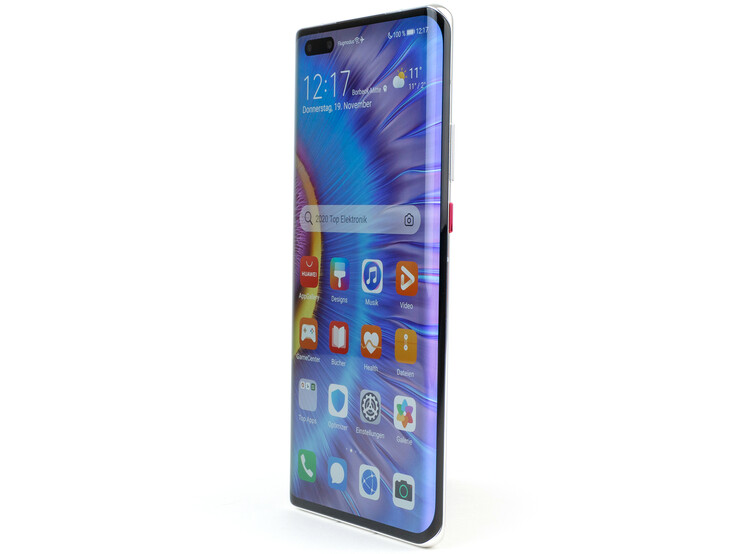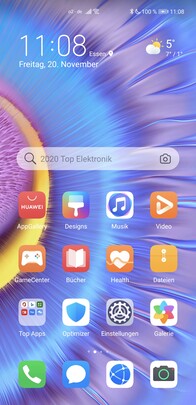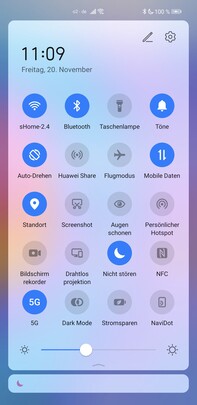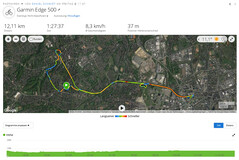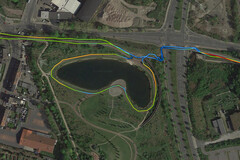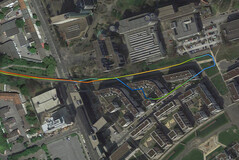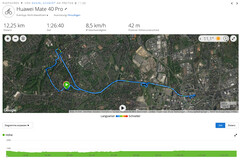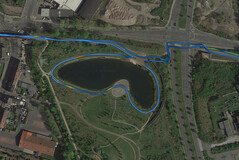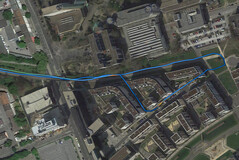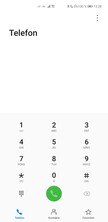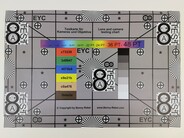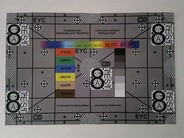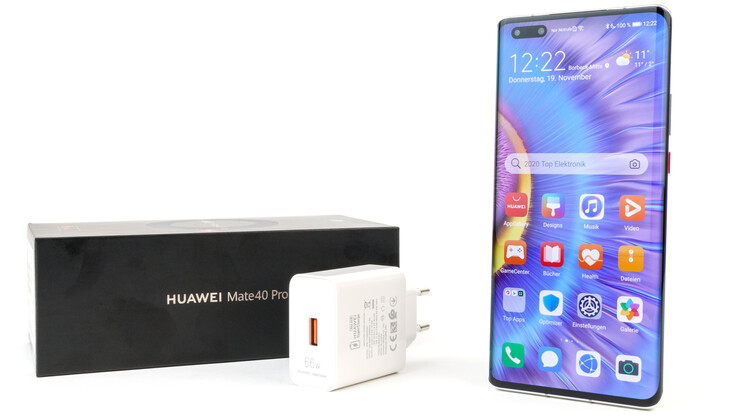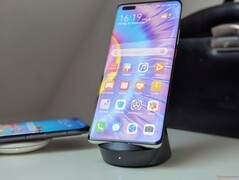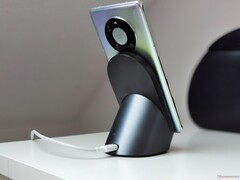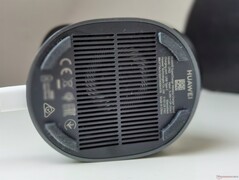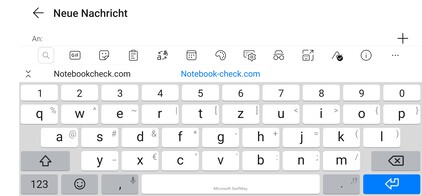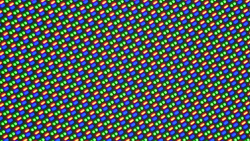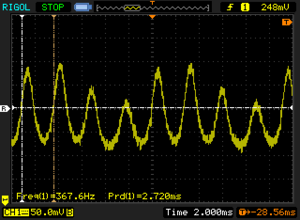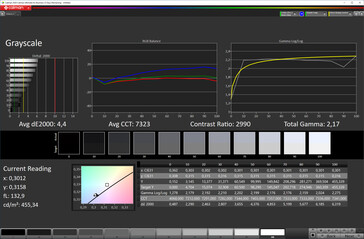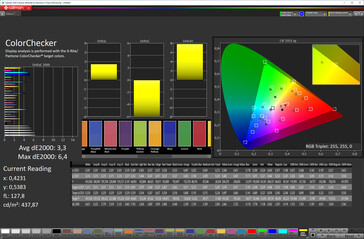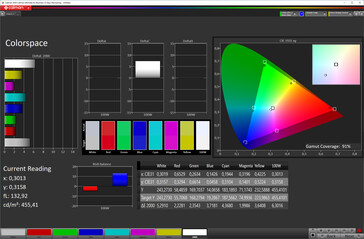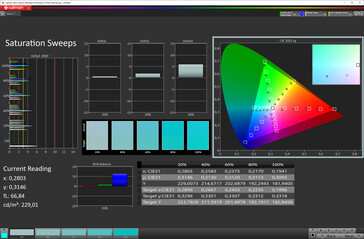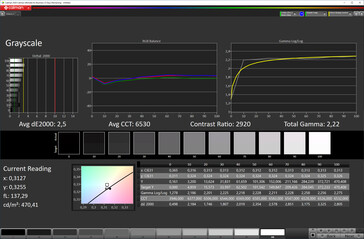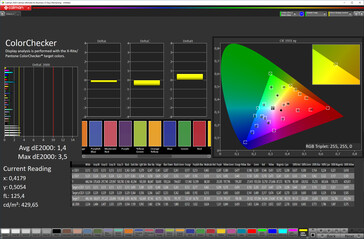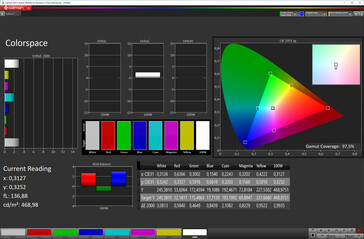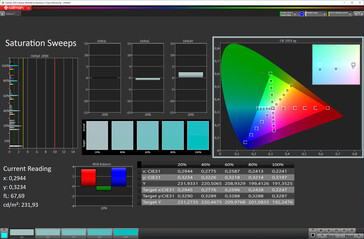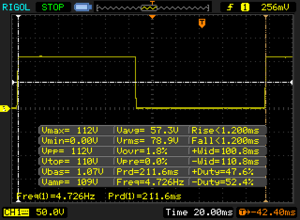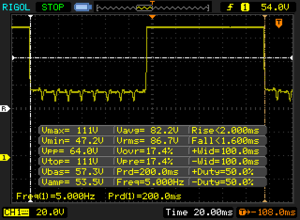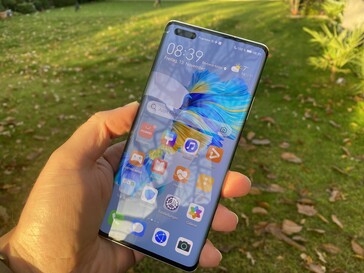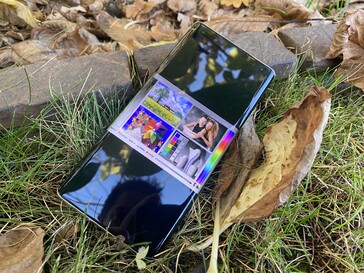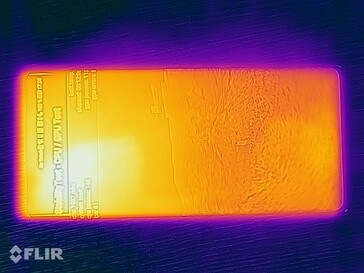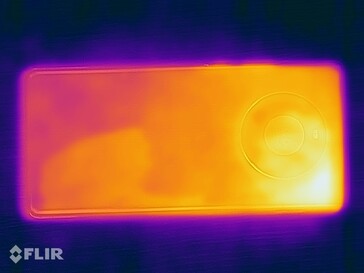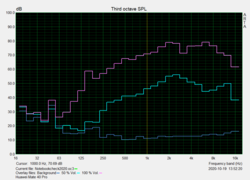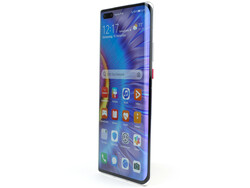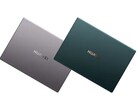Huawei Mate 40 Pro review - Top smartphone with handicap
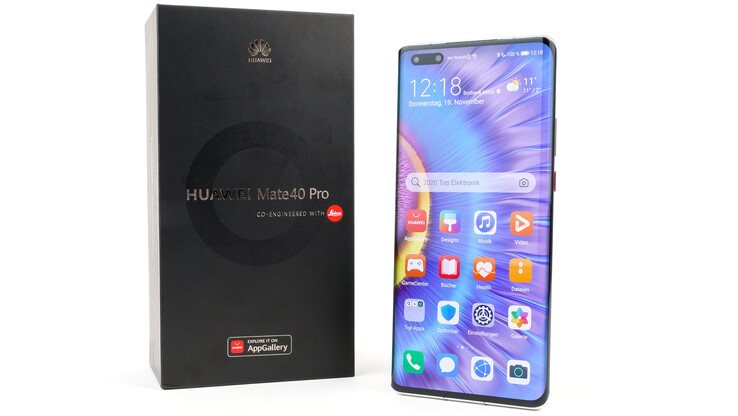
The Huawei Mate 40 series reappears with four models: The Mate 40, Mate 40 Pro, Mate 40 Pro+, and Mate 40 RS. Only the Pro version is coming to Europe this year, and this speaks volumes about the sales figures Huawei expects, which are due to the involuntary absence of Google services.
The Huawei Mate 40 Pro is powered by the Kirin 9000, which is particularly supposed to outperform the Snapdragon 865+ in all performance aspects. In addition, the Chinese provide 8 GB of RAM and 256 GB of internal storage; the latter can be expanded with a nano memory card. No compromises have to be made when it comes to connectivity either. Huawei promises the fastest 5G, Wi-Fi 6, Bluetooth 5.2, and USB 3.2. Whether with or without a cable, the Mate 40 Pro offers the latest data transfer technologies. The new Leica triple camera is also expected to set new standards.
Comparison devices
Rating | Date | Model | Weight | Drive | Size | Resolution | Price |
|---|---|---|---|---|---|---|---|
| 90.6 % v7 (old) | 11 / 2020 | Huawei Mate 40 Pro Kirin 9000, Mali-G78 MP24 | 212 g | 256 GB UFS 3.1 Flash | 6.76" | 2772x1344 | |
| 89 % v7 (old) | 12 / 2019 | Huawei Mate 30 Pro Kirin 990, Mali-G76 MP16 | 198 g | 256 GB UFS 3.0 Flash | 6.53" | 2400x1176 | |
| 89.6 % v7 (old) | 02 / 2021 | Samsung Galaxy Note20 Ultra Exynos 990, Mali-G77 MP11 | 208 g | 256 GB UFS 3.1 Flash | 6.90" | 3088x1440 | |
| 89.8 % v7 (old) | 11 / 2020 | Apple iPhone 12 Pro A14, A14 Bionic GPU | 189 g | 256 GB NVMe | 6.10" | 2532x1170 | |
| 88.2 % v7 (old) | 04 / 2020 | Xiaomi Mi 10 Pro SD 865, Adreno 650 | 208 g | 256 GB UFS 3.0 Flash | 6.67" | 2340x1080 | |
| 86.1 % v7 (old) | 03 / 2020 | Oppo Find X2 Pro SD 865, Adreno 650 | 202 g | 512 GB UFS 3.0 Flash | 6.70" | 3168x1440 |
Case - A lot of glass for the Mate 40 Pro
The Huawei Mate 40 Pro is only available in black and silver. However, the silver version is reminiscent of the precious metal only at steep viewing angles and otherwise shimmers in many colors (see the video below). Unfortunately, neither the white model nor the one with an imitation leather back are available in Germany.
Although the camera on the back protrudes 1.75 millimeters, the smartphone doesn't wobble on the table due to its wide design. The workmanship of the Mate 40 Pro is excellent. The glass panels on both the front and the back of the phone fit tightly and evenly with the metal frame, and twisting attempts can be carried out without any effects.
The smartphone is protected against the ingress of dust and water according to the IP68 standard. The cover of the card slot is of the same color as the frame and is flush with it. The tray itself is made of plastic and can hold either two nano SIM cards or one nano memory card instead of the second SIM.
Connectivity - The nano memory card slot dilemma, part 3
In terms of connectivity, Huawei has only done fine-tuning on the Mate 40 Pro. With USB 3.2 (Gen. 1, max. 5 Gb/s), it has a fast data interface that supports wired image output in addition to OTG and Power Delivery.
Expanding storage via a nano memory card is possible again. Huawei's own format may be more compact than a traditional microSD card, but it's also only available with a capacity of up to 256 GB. Since the introduction of the new memory slot in the Mate 20 Pro 2018, nothing has changed here, and other manufacturers haven't adopted the new model either. Although the exFAT file system is supported, formatting the card as internal storage is not possible.
There's no notification LED, but the always-on display can be used as an alternative. The infrared blaster is back on board, which can be used to control home entertainment peripherals, cameras or air-conditioning systems.
Software - EMUI 11 only with Android 10
The Huawei Mate 40 Pro uses a free variant of Android 10 with the current EMUI 11. Normally, the Mate smartphone would have been a candidate to feature the latest Android version, but due to the forbidden cooperation with Google, this has been delayed. Once again, the forced abandonment of Google services is not surprising. Huawei tries to compensate for this as conveniently as possible with their own AppGallery. However, since many apps can't be found there yet, a powerful tool was created with Petal Search, which searches for the corresponding APKs at the respective company websites or on APKPure. The installation is not as convenient as via a regular app store, but it's also doable for users with less technical knowledge. However, many updates have to be installed manually.
Likewise, an in-house map solution is not available yet. However, Petal Maps is already in the testing phase and should be available next year. Huawei also wants to close the gap in respect to mobile payments and present solutions for Europe next year as well.
Despite the trade war, the Mate 40 Pro has DRM certification (Widevine L1), so that even correspondingly protected streaming content can be enjoyed in its full glory.
Communication and GNSS - Wi-Fi 6 and 5G are worthy of reference
The Huawei Mate 40 Pro uses the current Wi-Fi 6 standard (IEEE 802.11 ax) to connect to WLAN networks. Not only does it use MIMO antenna technology, but it also uses VHT160 to achieve the highest possible data rates. This works brilliantly in combination with our Netgear Nighthawk AX 12 reference router, and the Mate 40 Pro is the fastest smartphone in our database so far. The Huawei smartphone is also convincing in terms of range.
In the best case, the Mate can connect to mobile data networks using 5G and aims to be the fastest here as well. Huawei hasn't yet provided any concrete figures, but the Balong modem in the SoC is expected to deliver twice the download rate and five times the upload rate compared to the X55 modem in the Snapdragon 865+. In terms of numbers, this would correspond to a data rate of up to 15 Gb/s in both directions - no, we didn't forget any decimal places. In everyday use, the Huawei phone shows good reception capabilities and a very broad frequency range for all mobile radio standards.
On top of that, the Mate 40 Pro is the first smartphone with Bluetooth 5.2.
The Huawei Mate 40 Pro's positioning has a lot to offer too and often supports several frequency bands simultaneously. Besides GPS (dual-band), Glonass, BeiDou (quad-band), Galileo (tri-band), and QZSS (dual-band), the Indian NavIC can also be used. SBAS is available as well. The satellite signal is obtained fast and comparatively precisely even inside buildings.
The Mate 40 Pro has to face the comparison with the Garmin Edge 500 bicycle computer on a short bike ride. The Huawei smartphone shows a somewhat more precise location here and is, therefore, optimally suited for more than just navigation tasks.
Telephone and call quality
The telephone app has a clear structure and is easy to use. In the SIM card management area, these can be administered and assigned, and functions such as WLAN calling or VoLTE can be switched on or off. If you're already able to use 5G, you should be sure to check the settings, since the latest standard needs to be activated first. Alternatively to the second nano SIM, an eSIM can also be used.
The call quality of the Huawei Mate 40 Pro is excellent as long as the phone is held to the ear. The transmission of the conversation is done very naturally, and even background noise is reliably filtered out. Speaker mode is also good in quiet environments, but it occasionally reverberates slightly.
Cameras - Strong triple camera in the Mate 40 Pro
A dual-camera setup is integrated into the display on the front side, and it also provides an additional ultra wide-angle lens for group selfies. Despite the new lens, there is still distortion towards the edges. This isn't the case with the normal wide-angle lens, but the image composition is similar on both of them. In general, the Mate 40 Pro takes good selfies, but they aren't great. Even without portrait mode, there's too much retouching, and the background bokeh is practically non-existent. Videos can also be recorded with the front-facing camera in Ultra HD (60 FPS).
The triple-camera setup on the back consists of a wide-angle lens (23 mm) with the same sensor that is found in the P40 Pro, an ultra wide-angle lens (18 mm), and a periscope camera (125 mm). The latter achieves a 5x optical magnification and is supported by an OIS. Digital magnification can be done up to 50x. The ultra wide-angle sensor is completely new and no longer works with pixel-binning like its predecessor, but instead, it uses 1.6 µm pixels that should provide an even better low-light experience than before. However, Huawei has also changed the camera for the worse, because the main sensor is identical to the one on the P40 Pro, but it has to do without optical image stabilization.
The image results are impressive, and the Mate 40 Pro convinces in just about every area. The HDR algorithms in particular produce spectacular pictures in some cases, which often can't be foreseen in the live view. When photographing a sunset, the sky was displayed in full color, but the meadow was almost in complete darkness. When the final image was displayed, the illumination was evenly bright without taking away from the sunset.
The color reproduction is quite strongly saturated, and especially green tones are displayed intensely; when taking close-ups, the white balance is occasionally a bit too cool for our taste. Furthermore, the ultra wide-angle lens provided pleasing results as well and is much better than on the competition but also not as good as the camera's main sensor. Its distortion correction works very well, so that we can only make out a small curvature on pictures taken from a very close distance to the subject. The optical zoom provides good image results, and even at maximum magnification, many details are preserved.
Videos can be recorded in Ultra HD at up to 60 frames per second at best. The Mate 40 Pro also supports an impressive HDR mode here as long as the footage isn't viewed on TVs that are too large, because at that size, you will notice that some of the details are lost with HDR. The sound of the videos is good and has low noise.
Naturally, the Mate 40 Pro offers many more features that we've already described in more detail in the review of the P40 Pro. New, however, is the use of the DCI-P3 color space.
Image comparison
Choose a scene and navigate within the first image. One click changes the position on touchscreens. One click on the zoomed-in image opens the original in a new window. The first image shows the scaled photograph of the test device.
Wide angleWide angleUltra wide angleZoom (5x)Low light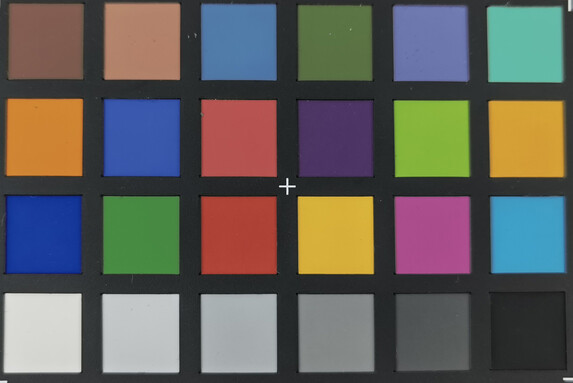
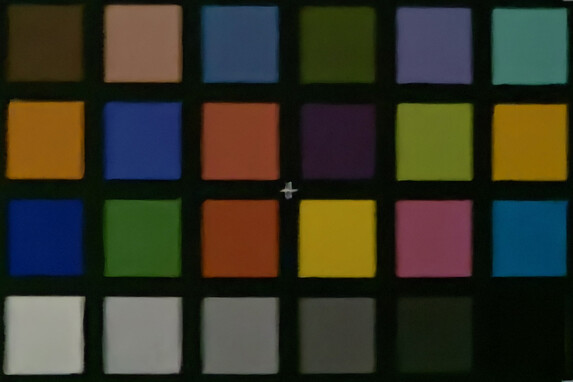
Accessories and warranty - Fast charger included in the box
Huawei provides a 24-month warranty for the Mate 40 Pro, and it can't be extended.
In addition to the smartphone itself, the scope of delivery includes a modular 66-watt power adapter, a USB cable (USB-A to USB-C), a transparent protective case, a SIM tool, and a headset. It's not entirely clear to us why Huawei still sometimes opts for USB-A when it comes to the charging cable, especially since some laptops of the Chinese manufacturer rely exclusively on the more modern version.
A flip cover (40 Euros (~$48)) can be optionally purchased, and the 2nd generation M-Pencil (100 Euros(~$119)) is also available. An appropriately powerful wireless charger that can exploit the potential of the Mate 40 Pro is not yet available in the portfolio. Consequently, prospective customers will have to make do with the SuperCharge Wireless Charger Stand (up to 40 watts, 129 Euros (~$153)). We were already able to test it. The charger performs its duties very reliably and charges the smartphone quickly. Another positive aspect is that the same 65-watt power adapter that is also used with the Mate Xs or MateBook is included in the box. The integrated fan that starts as soon as the charging process begins is a less appealing aspect, though. This makes using it at your bedside unthinkable, because it's not necessarily quiet either. We can only hope for an appropriate 50-watt charger that goes back to passive cooling.
Input devices and handling - The return of the volume rocker
After the volume rocker in the Mate 30 Pro was completely replaced by gesture controls, it's now back on board. Gesture control fans don't have to be sad, though, as this options is still available.
Huawei hasn't abandoned the non-touch gestures in the Mate 40 Pro either and has developed them a little further instead. As a result, not only can you scroll up and down without touching the display but also to the left and right. It's also possible now to pause or start a playback. This doesn't work completely intuitively yet and requires a little practice, but afterwards, these gestures can also be used effectively in everyday life. The touchscreen itself has very good gliding properties and reacts very quickly and reliably in all areas.
Pen support is back on board as well, but it probably only works with the new M-Pencil, which we unfortunately haven't been able to test yet. We couldn't connect the old M-Pen to the Mate 40 Pro.
Biometric security is provided by a fingerprint scanner integrated into the display that does its job reliably as long as it is intuitively touched correctly. We prefer the 3D face recognition with the ToF sensor. This is also very secure and recognizes the stored user faster and more reliably.
Display - Bright 90 Hz OLED in the Mate 40 Pro
The 6.76-inch OLED display of the Huawei Mate 40 Pro offers a high resolution of 2772x1344 pixels, which ensures a very good pixel density and correspondingly crisp display. The refresh rate reaches up to 90 Hz, and the panel supports HDR10.
Although the brightness is not as high as on the top models from Apple or Samsung, it has been increased considerably compared to its predecessor. With the ambient light sensor activated, the Mate 40 Pro reaches 778 cd/m² in the center of the display with a pure white background and 925 cd/m² with an even distribution of light and dark areas. If the brightness sensor is deactivated, a maximum of 471 cd/m² can be achieved.
The sides of the display are at a slope of 88 degrees. Users who don't like this look can adjust the sides to be displayed in black in the settings. In the same way, the camera notch in the display can be made invisible.
We can also see the flickering typical for OLEDs on the Mate 40 Pro. It occurs between 120.8 and 367.6 Hz. Even though the maximum frequency is a bit higher, the amplitude response is quite uneven, so that sensitive users can definitely expect discomfort. For such cases, however, Huawei has integrated a flickering-reduction mode (DC dimming), which makes the image reproduction visibly cooler, though.
| |||||||||||||||||||||||||
Brightness Distribution: 95 %
Center on Battery: 778 cd/m²
Contrast: ∞:1 (Black: 0 cd/m²)
ΔE ColorChecker Calman: 1.4 | ∀{0.5-29.43 Ø4.78}
ΔE Greyscale Calman: 2.5 | ∀{0.09-98 Ø5}
97.5% sRGB (Calman 2D)
Gamma: 2.22
CCT: 6530 K
| Huawei Mate 40 Pro OLED, 2772x1344, 6.8" | Huawei Mate 30 Pro OLED, 2400x1176, 6.5" | Samsung Galaxy Note20 Ultra Dynamic AMOLED, 3088x1440, 6.9" | Apple iPhone 12 Pro OLED, 2532x1170, 6.1" | Xiaomi Mi 10 Pro Super AMOLED, 2340x1080, 6.7" | Oppo Find X2 Pro AMOLED, 3168x1440, 6.7" | |
|---|---|---|---|---|---|---|
| Screen | -31% | -65% | 10% | 21% | -81% | |
| Brightness middle (cd/m²) | 778 | 592 -24% | 860 11% | 822 6% | 753 -3% | 778 0% |
| Brightness (cd/m²) | 782 | 605 -23% | 878 12% | 820 5% | 762 -3% | 775 -1% |
| Brightness Distribution (%) | 95 | 96 1% | 96 1% | 99 4% | 96 1% | 99 4% |
| Black Level * (cd/m²) | ||||||
| Colorchecker dE 2000 * | 1.4 | 2.5 -79% | 4.5 -221% | 1.2 14% | 0.9 36% | 4.4 -214% |
| Colorchecker dE 2000 max. * | 3.5 | 5.5 -57% | 10.4 -197% | 3.5 -0% | 1.6 54% | 8.7 -149% |
| Greyscale dE 2000 * | 2.5 | 2.6 -4% | 2.4 4% | 1.8 28% | 1.5 40% | 5.6 -124% |
| Gamma | 2.22 99% | 2.16 102% | 2 110% | 2.18 101% | 2.24 98% | 2.26 97% |
| CCT | 6530 100% | 6173 105% | 6466 101% | 6337 103% | 6415 101% | 7250 90% |
* ... smaller is better
Screen Flickering / PWM (Pulse-Width Modulation)
| Screen flickering / PWM detected | 367.6 Hz | ≤ 99 % brightness setting | |
The display backlight flickers at 367.6 Hz (worst case, e.g., utilizing PWM) Flickering detected at a brightness setting of 99 % and below. There should be no flickering or PWM above this brightness setting. The frequency of 367.6 Hz is relatively high, so most users sensitive to PWM should not notice any flickering. However, there are reports that some users are still sensitive to PWM at 500 Hz and above, so be aware. In comparison: 53 % of all tested devices do not use PWM to dim the display. If PWM was detected, an average of 8095 (minimum: 5 - maximum: 343500) Hz was measured. | |||
Due to the OLED technology, the Mate 40 Pro's panel can display absolute blacks, so that the contrast ratio tends towards infinity in theory.
The color reproduction is very accurate in the smaller sRGB color space (profile: Normal), and even the grayscales only show deviations that are actually perceptible to the human eye here and there. If you choose the larger DCI-P3 color space, you get a much cooler image.
Display Response Times
| ↔ Response Time Black to White | ||
|---|---|---|
| 2.4 ms ... rise ↗ and fall ↘ combined | ↗ 1.2 ms rise | |
| ↘ 1.2 ms fall | ||
| The screen shows very fast response rates in our tests and should be very well suited for fast-paced gaming. In comparison, all tested devices range from 0.1 (minimum) to 240 (maximum) ms. » 11 % of all devices are better. This means that the measured response time is better than the average of all tested devices (20.2 ms). | ||
| ↔ Response Time 50% Grey to 80% Grey | ||
| 3.6 ms ... rise ↗ and fall ↘ combined | ↗ 2 ms rise | |
| ↘ 1.6 ms fall | ||
| The screen shows very fast response rates in our tests and should be very well suited for fast-paced gaming. In comparison, all tested devices range from 0.165 (minimum) to 636 (maximum) ms. » 13 % of all devices are better. This means that the measured response time is better than the average of all tested devices (31.6 ms). | ||
The Huawei Mate 40 Pro outdoors on a clear autumn day.
The viewing-angle stability of the Huawei Mate 40 Pro is actually very good due to the OLED technology, but the steep edges can sometimes become quite ugly. Especially when the surface is very white and when viewed from the front, they are bathed in a sickly yellow color.
Performance - The Kirin 9000 makes everyone look outdated
Huawei makes the competition look pretty old with the current Kirin 9000. The 5 nm SoC is the only one of its kind that doesn't need a dedicated 5G modem, since it has one integrated directly into the chip; it also performs extremely well in terms of speed. The processor consists of three clusters: One Cortex-A77 at up to 3.13 GHz, three Cortex-A77 at up to 2.54 GHz, and four Cortex-A55 cores at up to 2.05 GHz. In addition, an ARM Mali-G78 MP24 is used for the graphics calculations.
Unfortunately, we could hardly do any benchmarks with our test device, because Huawei blocked them, and the apps couldn't be installed at all. Only the 3DMark test was able to be performed, and it shows that the Kirin 9000 makes the whole competition look pretty old. This is, however, tied to two conditions. First, performance mode needs to be activated, and second, the Vulkan API shouldn't be used. If the latter is activated, the performance of the Kirin 9000 suddenly drops significantly below the level of its predecessor, the Kirin 990, indicating poor driver optimization.
If performance mode is switched off, the SoC's performance in 3DMark Sling Shot Extreme (OpenGL ES 3.1, total: 6,345 points, graphics score: 7,144 points, physics score: 4,561 points) drops by about a third; but it's still above the Mate 30 Pro with activated performance mode, which is mainly due to the much stronger GPU.
| Basemark ES 3.1 / Metal - offscreen Overall Score (sort by value) | |
| Huawei Mate 40 Pro | |
| Apple iPhone 12 Pro | |
| Xiaomi Mi 10 Pro | |
| Oppo Find X2 Pro | |
| Average HiSilicon Kirin 9000 (n=1) | |
| Average of class Smartphone (205 - 7731, n=35, last 2 years) | |
| GFXBench 3.0 | |
| on screen Manhattan Onscreen OGL (sort by value) | |
| Huawei Mate 30 Pro | |
| Samsung Galaxy Note20 Ultra | |
| Apple iPhone 12 Pro | |
| Xiaomi Mi 10 Pro | |
| Oppo Find X2 Pro | |
| Average of class Smartphone (18 - 166, n=157, last 2 years) | |
| 1920x1080 1080p Manhattan Offscreen (sort by value) | |
| Huawei Mate 30 Pro | |
| Samsung Galaxy Note20 Ultra | |
| Apple iPhone 12 Pro | |
| Xiaomi Mi 10 Pro | |
| Oppo Find X2 Pro | |
| Average of class Smartphone (12 - 606, n=156, last 2 years) | |
| GFXBench 3.1 | |
| on screen Manhattan ES 3.1 Onscreen (sort by value) | |
| Huawei Mate 30 Pro | |
| Samsung Galaxy Note20 Ultra | |
| Apple iPhone 12 Pro | |
| Xiaomi Mi 10 Pro | |
| Oppo Find X2 Pro | |
| Average of class Smartphone (11 - 166, n=157, last 2 years) | |
| 1920x1080 Manhattan ES 3.1 Offscreen (sort by value) | |
| Huawei Mate 30 Pro | |
| Samsung Galaxy Note20 Ultra | |
| Apple iPhone 12 Pro | |
| Xiaomi Mi 10 Pro | |
| Oppo Find X2 Pro | |
| Average of class Smartphone (8.4 - 413, n=156, last 2 years) | |
| AnTuTu v8 - Total Score (sort by value) | |
| Huawei Mate 30 Pro | |
| Samsung Galaxy Note20 Ultra | |
| Apple iPhone 12 Pro | |
| Xiaomi Mi 10 Pro | |
| Oppo Find X2 Pro | |
| VRMark - Amber Room (sort by value) | |
| Huawei Mate 30 Pro | |
| Xiaomi Mi 10 Pro | |
| Oppo Find X2 Pro | |
In the browser benchmarks, the Huawei Mate 40 Pro can easily leave the assembled Android competition behind. Only the iPhone 12 Pro is in a class of its own.
| Jetstream 2 - 2.0 Total Score | |
| Apple iPhone 12 Pro (Safari Mobile 14) | |
| Average of class Smartphone (23.8 - 387, n=149, last 2 years) | |
| Huawei Mate 40 Pro (Huawei Browser 11) | |
| Average HiSilicon Kirin 9000 (n=1) | |
| Huawei Mate 30 Pro (Chrome 78) | |
| Xiaomi Mi 10 Pro (Chrome 81) | |
| Oppo Find X2 Pro (Chrome 80) | |
| Samsung Galaxy Note20 Ultra (Chrome 84) | |
| JetStream 1.1 - Total Score | |
| Apple iPhone 12 Pro (Safari Mobile 14) | |
| Huawei Mate 40 Pro (Huawei Browser 11) | |
| Average HiSilicon Kirin 9000 (n=1) | |
| Huawei Mate 30 Pro (Chrome 78) | |
| Xiaomi Mi 10 Pro (Chrome 81) | |
| Oppo Find X2 Pro (Chrome 80) | |
| Samsung Galaxy Note20 Ultra (Chrome 84) | |
| Speedometer 2.0 - Result 2.0 | |
| Average of class Smartphone (15.2 - 643, n=122, last 2 years) | |
| Apple iPhone 12 Pro (Safari Mobile 14) | |
| Huawei Mate 40 Pro (Huawei Browser 11) | |
| Average HiSilicon Kirin 9000 (n=1) | |
| Huawei Mate 30 Pro (Chrome 78) | |
| Oppo Find X2 Pro (Chrome 80) | |
| Xiaomi Mi 10 Pro (Chrome 81) | |
| WebXPRT 3 - Overall | |
| Apple iPhone 12 Pro (Safari Mobile 14) | |
| Average of class Smartphone (38 - 380, n=31, last 2 years) | |
| Huawei Mate 40 Pro (Huawei Browser 11) | |
| Average HiSilicon Kirin 9000 (n=1) | |
| Huawei Mate 30 Pro (Chrome 78) | |
| Samsung Galaxy Note20 Ultra (Chrome 84) | |
| Xiaomi Mi 10 Pro (Chrome 81) | |
| Oppo Find X2 Pro (Chrome 80) | |
| Octane V2 - Total Score | |
| Apple iPhone 12 Pro (Safari Mobile 14) | |
| Average of class Smartphone (2228 - 121337, n=197, last 2 years) | |
| Huawei Mate 40 Pro (Huawei Browser 11) | |
| Average HiSilicon Kirin 9000 (n=1) | |
| Huawei Mate 30 Pro (Chrome 78) | |
| Oppo Find X2 Pro (Chrome 80) | |
| Xiaomi Mi 10 Pro (Chrome 81) | |
| Samsung Galaxy Note20 Ultra (Chrome 84) | |
| Mozilla Kraken 1.1 - Total | |
| Samsung Galaxy Note20 Ultra (Chrome 84) | |
| Oppo Find X2 Pro (Chrome 80) | |
| Xiaomi Mi 10 Pro (Chrome 81) | |
| Huawei Mate 30 Pro (Chrome 78) | |
| Huawei Mate 40 Pro (Huawei Browser 11) | |
| Average HiSilicon Kirin 9000 (n=1) | |
| Average of class Smartphone (257 - 28190, n=155, last 2 years) | |
| Apple iPhone 12 Pro (Safari Mobile 14) | |
* ... smaller is better
At 256 GB, the UFS 3.1 storage of the Mate 40 Pro is adequately large. However, in contrast to the competition, Huawei succeeds in exploiting the storage's potential better, which is mainly reflected in the high write speeds.
Nevertheless, the memory card slot is rather mediocre and doesn't make full use of the NM card's capabilities.
| Huawei Mate 40 Pro | Huawei Mate 30 Pro | Samsung Galaxy Note20 Ultra | Xiaomi Mi 10 Pro | Oppo Find X2 Pro | Average 256 GB UFS 3.1 Flash | Average of class Smartphone | |
|---|---|---|---|---|---|---|---|
| AndroBench 3-5 | -15% | -22% | -21% | -33% | -2% | 16% | |
| Sequential Read 256KB (MB/s) | 2037 | 1781 -13% | 1782 -13% | 1739 -15% | 1606 -21% | 1757 ? -14% | 2228 ? 9% |
| Sequential Write 256KB (MB/s) | 1321 | 401.8 -70% | 802 -39% | 750 -43% | 729 -45% | 1204 ? -9% | 1852 ? 40% |
| Random Read 4KB (MB/s) | 325 | 226.4 -30% | 186.7 -43% | 264.9 -18% | 202.6 -38% | 287 ? -12% | 296 ? -9% |
| Random Write 4KB (MB/s) | 277.6 | 259.2 -7% | 217.7 -22% | 258.5 -7% | 205 -26% | 318 ? 15% | 339 ? 22% |
| Sequential Read 256KB SDCard (MB/s) | 70.2 ? | 82.5 ? 18% | 65.6 ? -7% | 75.9 ? 8% | |||
| Sequential Write 256KB SDCard (MB/s) | 60.9 ? | 69.2 ? 14% | 55.6 ? -9% | 61.9 ? 2% |
Games - The software makes the difference
The Huawei Mate 40 Pro is a real powerhouse and offers more than enough power for all Android-based games. While the benchmarks with GameBench run smoothly, there are rather minor problems at the software level.
For example, the new Ultra HD setting is not available in PUBG Mobile, and we couldn't even squeeze higher frame rates than 60 Hz out from the Mate 40 Pro. Armajet is actually a title that guarantees high compatibility, but 60 Hz was the limit here as well.
However, the tested games run without problems and very smoothly. The Huawei smartphone can also convince in terms of control and sound.
Emissions - The Mate 40 Pro gets hot
Temperature
The surface temperatures of the Huawei Mate 40 Pro are pleasantly low in idle usage and only rise slightly under continuous load.
Unfortunately, because GFXBench can't be installed on our test device, we can't run the mandatory battery test for the stress test at this point. However, the one in 3DMark Wild Life works wonderfully and shows quite clearly that Huawei doesn't succeed in maintaining its high performance over a prolonged period of time. At the beginning, the score is 6,773 points; the lowest value in the penultimate run is only 3,341 points.
| 3DMark - Wild Life Stress Test Stability | |
| Huawei P40 Pro | |
| Google Pixel 5 | |
| Apple iPhone 12 Pro | |
| Huawei Mate 40 Pro | |
| Samsung Galaxy Note20 Ultra | |
(+) The maximum temperature on the upper side is 31.6 °C / 89 F, compared to the average of 35.2 °C / 95 F, ranging from 21.9 to 247 °C for the class Smartphone.
(+) The bottom heats up to a maximum of 29.5 °C / 85 F, compared to the average of 34 °C / 93 F
(+) In idle usage, the average temperature for the upper side is 28 °C / 82 F, compared to the device average of 32.9 °C / 91 F.
Speakers
The experiments with new types of speakers seem to be a thing of the past. After the attempts to hide a second one under the display or in the USB port, Huawei has now finally given the Mate 40 Pro full-fledged dual speakers. And they even sound really good, and you can even hear some bass.
However, there is no audio jack, and Huawei doesn't include a corresponding USB-C to 3.5 mm audio jack adapter with its smartphone. Since wireless earbuds are more popular anyway, the Chinese have included a new, high-resolution audio codec - L2HC. Unfortunately, this is only supported by the in-house Huawei FreeBuds Studio so far. Alternatively, the SBC, AAC, and LDAC codecs are also available. However, users will have to do without Qualcomm's aptX, aptX HD or aptX Adaptive codecs. Since the Mate 40 Pro is already equipped with the latest Bluetooth 5.2 technology, we would have expected the new LC3 codec, which is part of the BT5.2 specifications, to be on board. Unfortunately, this is not the case.
Huawei Mate 40 Pro audio analysis
(+) | speakers can play relatively loud (87.5 dB)
Bass 100 - 315 Hz
(-) | nearly no bass - on average 18.8% lower than median
(±) | linearity of bass is average (11.9% delta to prev. frequency)
Mids 400 - 2000 Hz
(+) | balanced mids - only 3.7% away from median
(+) | mids are linear (4.3% delta to prev. frequency)
Highs 2 - 16 kHz
(+) | balanced highs - only 4.9% away from median
(+) | highs are linear (5.7% delta to prev. frequency)
Overall 100 - 16.000 Hz
(+) | overall sound is linear (14.1% difference to median)
Compared to same class
» 1% of all tested devices in this class were better, 1% similar, 98% worse
» The best had a delta of 11%, average was 35%, worst was 134%
Compared to all devices tested
» 16% of all tested devices were better, 4% similar, 80% worse
» The best had a delta of 4%, average was 24%, worst was 134%
Samsung Galaxy Note20 Ultra audio analysis
(+) | speakers can play relatively loud (88.8 dB)
Bass 100 - 315 Hz
(-) | nearly no bass - on average 22.2% lower than median
(±) | linearity of bass is average (10.7% delta to prev. frequency)
Mids 400 - 2000 Hz
(+) | balanced mids - only 4.5% away from median
(+) | mids are linear (3% delta to prev. frequency)
Highs 2 - 16 kHz
(+) | balanced highs - only 3.1% away from median
(+) | highs are linear (1.7% delta to prev. frequency)
Overall 100 - 16.000 Hz
(+) | overall sound is linear (14.7% difference to median)
Compared to same class
» 2% of all tested devices in this class were better, 2% similar, 96% worse
» The best had a delta of 11%, average was 35%, worst was 134%
Compared to all devices tested
» 19% of all tested devices were better, 4% similar, 77% worse
» The best had a delta of 4%, average was 24%, worst was 134%
Battery life - Shorter than expected
Energy consumption
The measurements show increased power consumption in idle usage with a refresh rate of 90 Hz, but if this is reduced to 60 Hz, consumption drops by just 0.08 watts. Under load, however, the SoC is energy-efficient despite the active performance mode.
The 4,400 mAh battery is fully recharged within 46 minutes with the 66-watt power adapter. The 60% mark is hit after only 18 minutes, and it only takes four more minutes to reach 70%.
| Off / Standby | |
| Idle | |
| Load |
|
Key:
min: | |
| Huawei Mate 40 Pro 4400 mAh | Huawei Mate 30 Pro 4500 mAh | Samsung Galaxy Note20 Ultra 4500 mAh | Apple iPhone 12 Pro 2815 mAh | Xiaomi Mi 10 Pro 4500 mAh | Oppo Find X2 Pro 4260 mAh | Average HiSilicon Kirin 9000 | Average of class Smartphone | |
|---|---|---|---|---|---|---|---|---|
| Power Consumption | 9% | 7% | 37% | 18% | -58% | 0% | -16% | |
| Idle Minimum * (Watt) | 1.01 | 0.87 14% | 0.65 36% | 0.64 37% | 0.61 40% | 1.47 -46% | 1.01 ? -0% | 0.842 ? 17% |
| Idle Average * (Watt) | 2.12 | 1.75 17% | 1.06 50% | 1.22 42% | 1.19 44% | 3.43 -62% | 2.12 ? -0% | 1.439 ? 32% |
| Idle Maximum * (Watt) | 2.15 | 1.83 15% | 1.49 31% | 1.24 42% | 1.23 43% | 3.52 -64% | 2.15 ? -0% | 1.624 ? 24% |
| Load Average * (Watt) | 3.94 | 3.85 2% | 4.91 -25% | 3.04 23% | 4.18 -6% | 6.2 -57% | 3.94 ? -0% | 7.03 ? -78% |
| Load Maximum * (Watt) | 6.53 | 6.64 -2% | 10.29 -58% | 3.86 41% | 8.53 -31% | 10.63 -63% | 6.53 ? -0% | 11.3 ? -73% |
* ... smaller is better
Battery life
Battery life is weaker compared to the Mate 30 Pro, which is not only due to the slightly smaller battery but rather to a lower efficiency of the communication modules. The Mate 40 Pro shows strong battery life losses in the tests with activated WLAN in particular.
Especially in the practical WLAN test with an adjusted display brightness of 150 cd/m², the Huawei smartphone takes last place in the comparison field. An unusual sight. Let's hope that future updates correct this deficit.
| Huawei Mate 40 Pro 4400 mAh | Huawei Mate 30 Pro 4500 mAh | Samsung Galaxy Note20 Ultra 4500 mAh | Apple iPhone 12 Pro 2815 mAh | Xiaomi Mi 10 Pro 4500 mAh | Oppo Find X2 Pro 4260 mAh | |
|---|---|---|---|---|---|---|
| Battery runtime | 25% | 7% | 30% | 20% | 7% | |
| Reader / Idle (h) | 20.9 | 36.2 73% | 20.4 -2% | 34.9 67% | 35.6 70% | |
| H.264 (h) | 16.7 | 18.3 10% | 16.6 -1% | 18.6 11% | 16.2 -3% | |
| WiFi v1.3 (h) | 10.2 | 13.7 34% | 10.7 5% | 13 27% | 14.4 41% | 10.9 7% |
| Load (h) | 4.5 | 3.7 -18% | 5.6 24% | 5.2 16% | 3.3 -27% |
Pros
Cons
Verdict - High-performance Huawei smartphone
From a technical standpoint, the Huawei Mate 40 Pro is an excellently equipped smartphone. The display isn't as bright as on current top-of-the-line devices from the competition, but it doesn't have to hide behind it either. The Chinese flex their muscles with the SoC in particular, even though we haven't been able to perform all the tests yet due to the benchmark block on our test device.
The Huawei smartphone is also strong when it comes to its positioning properties and call quality. The triple camera was also convincing in the test. The communication modules are state of the art, but they reduce the battery life and deprive the Mate 40 Pro of one of its core competencies. Only future updates will show whether this is due to the SoC architecture or to a driver problem.
The Huawei Mate 40 Pro is technically one of the best smartphones currently available, but it has to deal with software limitations.
Huawei has made improvements to the speakers, since they sound really good now. Due to the trade embargo restrictions, however, not only are there restrictions due to the lack of Google services, but the audio codecs from Qualcomm have to be dropped too. At least the Mate 40 Pro has a DRM certification despite the adverse circumstances.
Huawei Mate 40 Pro
- 08/31/2022 v7 (old)
Daniel Schmidt




